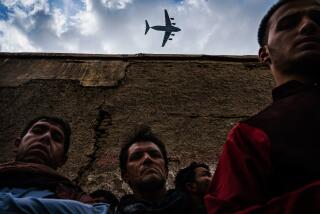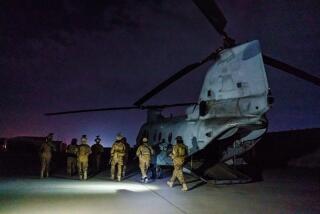Obama’s new players on Afghanistan
- Share via
The message the White House tried to send with last week’s changes at the Pentagon, the Central Intelligence Agency and the U.S. command in Afghanistan was continuity. This wasn’t a change of direction, aides said; it was merely a shuffling of the players necessitated by Defense Secretary Robert M. Gates’ retirement.
But there’s more here than just a rearrangement of the seating chart.
U.S. policy in Afghanistan is turning a corner — from a military surge to a military drawdown, from battering the Taliban to enticing them into negotiations. And that transition made it a natural and sensible time to put in a new team.
President Obama’s old team — Gates at the Pentagon and Army Gen. David H. Petraeus in Afghanistan — were the architects of the surge. His new team, Leon E. Panetta at the Pentagon and Marine Lt. Gen. John R. Allen and Ambassador Ryan Crocker in Afghanistan, will manage the drawdown — and, if all goes well, they’ll be midwives of a peace process too.
There were good reasons to move the players around.
In 2009, Obama accepted the pleas of Gates and his military leaders that they be given 100,000 troops to launch a “surge” in Afghanistan much like the one that helped bring Iraq’s civil war under control in 2007. But Obama also set a deadline; this would be the last escalation, and troops would begin to come home by July 2011,
That Afghan surge is now mostly complete, and Obama aides argue that it has been a success. “Remember that the surge had two key goals,” a White House official told me last week. “One, to stop the Taliban’s momentum; two, to give time and space for the Afghan security forces to grow. Both have gotten done, by and large.”
So now, in Obama’s view, the time has come to begin withdrawing U.S. troops, handing leadership of the war to Afghan government forces and enticing the Taliban into peace negotiations to end the conflict.
One model for that transition, Obama said Thursday, is Iraq, where a military surge launched by President George W. Bush (and criticized by Obama at the time) helped quell Sunni and Shiite insurgencies and open the way to political negotiations among the country’s competing factions.
Both of the men the president is sending to Afghanistan, Allen and Crocker, are veterans of that drama in Iraq.
Allen, the new military commander, played a key role in negotiating peace agreements with Sunni insurgents in Anbar province, insurgents who only months before had been planting roadside bombs to kill U.S. forces.
Nobody’s suggesting that the war in Afghanistan will end exactly the same way as the war in Iraq. Southern Afghanistan is very different from western Iraq; the Islamist Taliban, with havens across the border in Pakistan, have different power bases and different goals than the sheiks of Anbar province. But the two wars have this in common: The main goals of U.S. policy are to strengthen government forces, negotiate with the enemy and withdraw all but a few troops without leaving chaos behind. That is a mission Allen knows well.
In planning for an orderly withdrawal, it’s also going to matter that the secretary of Defense is no longer Gates, a Republican who argued strongly for the surge and might want to give it more time. Panetta, a Democrat, has reportedly been more skeptical.
The pace of the U.S. drawdown hasn’t been decided. Obama’s “old” Afghanistan team, led by Petraeus and Gates, will soon propose options for the initial drawdown from the current surge level of about 100,000 troops that has been promised for July.
The military has been lobbying to keep this year’s drawdown modest, because they want to keep as many combat troops in the field as they can for the “fighting season” in summer and fall. The number hasn’t been settled, but the White House rejected early suggestions that this year’s drawdown be virtually invisible and limited to noncombat troops.
“This drawdown will start in July,” the White House official told me. “It will include combat troops. And there will be a glide path, a slope through 2014,” when Afghan President Hamid Karzai says his forces will be ready to take over the lead role in the war.
That glide path, officials and experts suggest, could include withdrawals of roughly 20,000 troops each year beginning in 2012, leaving perhaps 25,000 behind as advisors after 2014.
Does anything cloud this optimistic picture of a responsible transition? Plenty.
First, the administration is still sending a complicated, mixed message. The military wants the Taliban to notice that almost 100,000 U.S. forces will still be fighting after July; the White House wants Karzai and the American public to notice that the long-promised drawdown is really going to happen.
Second, the administration’s optimism is concentrated on the military side of the equation, not the civilian side. Officials say the Taliban has suffered serious damage in the fighting of the last year, and that the Afghan army has grown faster and better than initially expected. But on the civilian side, Karzai’s government has made little progress in reducing corruption and attracting durable support, especially in the Pashtun south. And there has been no real sign that the Taliban leaders are ready for the kind of peace negotiations that the administration says are the only realistic way to end the war.
Conflicts like Afghanistan’s don’t end in neat, decisive victories for either side. But a corner is being turned. The focus is no longer on escalation; from here on, it’s on a drawdown and transition. That’s the mission for which Obama designed his new team.
More to Read
A cure for the common opinion
Get thought-provoking perspectives with our weekly newsletter.
You may occasionally receive promotional content from the Los Angeles Times.










